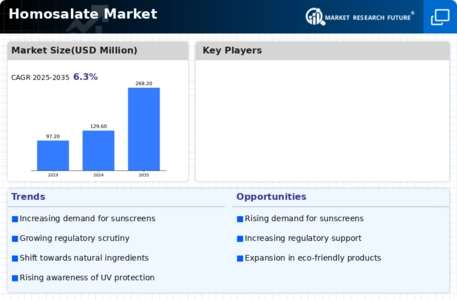Top Industry Leaders in the Homosalate Market

Basking in the spotlight of the global sunscreen industry, the homosalate market is a hidden gem with sunscreen's active ingredient at its core. This UV-absorbing wonder not only safeguards skin from harmful rays but also ignites a fierce battle for market share among established players and nimble innovators. Let's unravel the strategies, trends, and recent developments shaping this dynamic ecosystem.
Strategies Shielding Market Share:
-
Riding the SPF Wave: Leading companies like BASF and Spectrum Chemical Manufacturing Corporation are expanding their homosalate offerings to cater to the rising demand for high-SPF sunscreens, a trend driven by growing sun-safety awareness. -
Beyond the Beach: Diversification is key. Players like Lonza are venturing beyond traditional sunscreens, incorporating homosalate into personal care products like lip balms and moisturizers, expanding their market reach. -
Sustainability Spotlight: Green credentials are the new must-have. Sun Chemical Corporation is leading the charge by developing eco-friendly production processes and exploring bio-based alternatives for homosalate, aligning with environmental consciousness and regulations. -
Geographic Prowess: Emerging markets like China and India present fertile ground for growth. Nanjing COSMOS Chemical has strategically established production facilities in these regions to capitalize on the burgeoning demand for affordable sunscreen ingredients. -
Vertical Integration: Gaining control of the supply chain is crucial. Hongda Group is acquiring raw material sources and investing in refining technologies, ensuring quality control and cost-effectiveness while reducing dependence on external suppliers.
Factors Shaping Market Share:
-
Purity Matters: Different purities cater to distinct needs. Above 98% pure homosalate is used in high-end sunscreens, while lower purities find application in cosmetics and other personal care products. Yue Yang Dong Run Chemical excels at tailoring purity levels to specific formulations. -
Regulatory Landscape: Stringent regulations on sunscreen ingredients influence market dynamics. The European Union's Cosmetics Regulation, for instance, restricts the concentration of homosalate, impacting its use in certain sunscreen products. -
Regional Demand: Sun habits vary across the globe. Asia-Pacific leads due to its high sun exposure and growing skin-care consciousness, while Europe and North America prioritize high-performance, eco-friendly options. Ampak Company adapts its homosalate offerings to regional preferences. -
Technological Advancements: New production techniques, UV-absorbing properties, and even delivery systems can disrupt the market. ATK Chemical, for example, is pioneering encapsulation technologies to enhance homosalate's photostability and reduce potential environmental concerns. -
Cost Competitiveness: Price remains a crucial factor, particularly for mass-produced sunscreens. Asian manufacturers often offer cost-effective options, while European and American players command premium prices for high-purity, innovative homosalate solutions. Natural micron chem tech focuses on balancing affordability with quality.
Key Players:
Spectrum Chemical Manufacturing Corporation, Hongda Group, Yue Yang Dong Run Chemical, Ampak Company, ATK Chemical, and Natural micron chem tech
Recent Developments:
August: Spectrum Chemical Manufacturing Corporation unveils a novel bio-based homosalate derived from plant oils, generating interest from eco-conscious sunscreen brands.
September: The European Union proposes further restrictions on the use of certain sunscreen ingredients, including homosalate, prompting research and development into safer alternatives.
October: China implements stricter sun protection regulations, boosting demand for high-SPF sunscreens containing homosalate.
November: A consortium of sunscreen manufacturers and ingredient suppliers launches a research initiative to develop standardized testing protocols for homosalate's environmental impact, promoting transparency and responsible sourcing.
December: A major research institute identifies a potential link between homosalate and coral bleaching, sparking concerns and pushing for further safety assessments.

